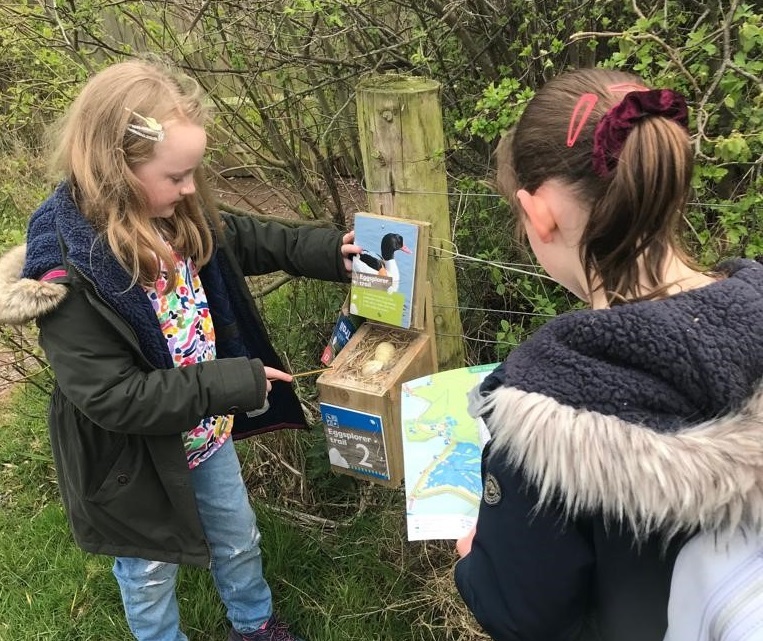Easter events
Bluebell walks
Join Ranger Jon for a guided walk in East Devon’s glorious woodlands as he goes in search of bluebells. For spectacular views of bluebells and other woodland specialities join Jon at Holyford Woods on the 27th April or Knapp Copse on the 3rd May.
Easter trail prizes at Seaton Wetlands
 Come down to Seaton Wetlands this Easter to take part in our Easter trail. Grab your trail leaflet from the Discovery Hut for £3. After you have completed your trail head back to the Discovery Hut to claim your prize! There's no need to book, just turn up and join in the fun.
Spring migration
Image credit: Tom Wallis
Spring is the season for migration. Birds head back north after a winter spent feeding and sheltering in the UK as we are joined by our southern visitors like swifts and swallows. Our nature reserves and hedgerows come alive with the sights and sound of birds courting, insect’s buzzing and wildflowers blooming.
Sand martins are amongst the species that join us from Africa along with painted lady butterflies and other invertebrates. When the conditions are perfect, flocks of birds and swarms of butterflies can be seen on the move. We are hoping this will be the year that the sand martins choose to breed in the purpose built martin cliff at Seaton Wetlands. If you walk by and hear a loud chattering of birds it could be our sound recording. We are hoping to entice the sociable sand martins to come and breed, they nest in large groups in burrows that they dig out in steep sandy cliffs.
Next time you are out for a stroll on your local nature reserve take time to stop and take note of the changes around you. Can you hear any birds that you haven’t heard yet this year? What flowers have popped up since you last visited? And if you see a sand martin checking out our cliff please let us know!
Ecological surveys on a brownfield site in Colyton discovered the presence of protected slowworms and so Seaton Wetlands was chosen as a suitable receptor site for the amazing legless lizards. The site was protected by a perimeter reptile fence to isolate the resident reptiles, and a series of felt mats was put out to attract the slowworms to seek warmth below and allow them to be safely caught and moved to the nature reserve.
Seaton Wetlands is home to slowworms, along with other native reptiles such as common lizards and grass snakes, so its habitat is well suited to these creatures. While it is unfortunate that their current location will be disturbed in the development process, at least these individuals could be saved and moved to help diversify the genetic stock of what can quickly become a very isolated population. The grasslands of Stafford Marsh were chosen as the receiver site as there is good connectivity from here to many other sites via rough grassland and hedgerows and so the bolstered populations of the Local Nature Reserve are able to move easily through the local landscape to find suitable new homes in the future.
Early signs of breeding
With a rather unusual spring with a prolonged cold spell and northerly winds, many of the migrant birds which breed in East Devon have been held back on the continent. That’s not to say that spring hasn’t officially sprung, as evidence has been spotted among many species on the wetlands.
After a couple of years missing in action, the Colyford Common Kestrels are back in the nest box containing CCTV! Mating was seen in the adjacent dead tree and the female has been taking shelter inside the box when its raining, and the pair have successfully evicted a squirrel which had built a considerable drey inside the box in the early New Year. The first egg should be laid any day now and a new egg follows every other day until 5 or 6 are laid and incubated.
Oystercatchers are paring up with a maximum count of three pairs roosting on islands at Black Hole Marsh, and a new pair seen regularly at Seaton Marshes, too. While total numbers are relatively small of this breeding wader, increasing breeding effort each year is in direct contrast to the National picture where their numbers are falling considerably.
Around the hedgerows smaller birds are well underway with nesting. Robins and dunnocks have been displaying courtship behaviour for many weeks and this week a male wren was spotted carrying lining material back to the nest. Male wrens are industrious birds, creating four or five domed nests out of moss in a variety of positions. When finished he will lead the female to each in turn and she will pick the one she likes the best, give him the nod, and he will line that one nest with insulating materials and abandon the rest. A quite incredible piece of ecology!
Have a go at making your own leaf and flower batiked eggs. You can achieve different colours by using dyes made from boiling onion skins, red cabbage leaves or even nettles!
|